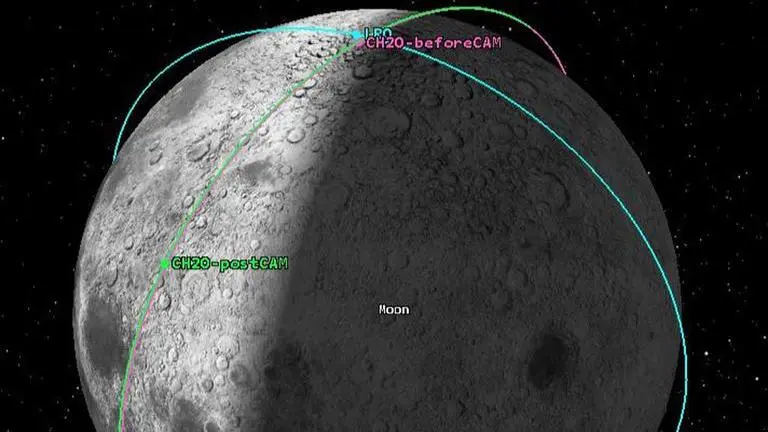Updated 17 November 2021 at 09:52 IST
ISRO performs manoeuvre to avoid collision between Chandrayaan-2 and NASA’s lunar orbiter
In October, the Chandrayaan-2 mission's lunar orbiter was relocated from its 100-kilometres circular, polar orbit to avoid a close contact with NASA’s LRO.
- Science News
- 3 min read

In October, the Chandrayaan-2 mission's lunar orbiter was relocated from its 100-kilometres circular, polar orbit to avoid close contact with NASA’s Lunar Reconnaissance Orbiter (LRO) near the north pole, according to the Indian Space Research Organisation (Isro). This was the first time ISRO had attempted a close approach manoeuvre for a space exploration mission. To avoid a collision, ISRO keeps a close eye on the sky for debris and other satellites. According to ISRO, all such manoeuvres have so far been limited to satellites orbiting the planet.
On October 20 at 11.15 a.m., a very close conjunction of the Indian and US orbiters, both of which are in polar orbits that cross over both poles of the moon, was expected. The distance between the orbits of the two spacecraft at the time would have been less than 100m. At the time of the closest approach, the satellites would have been around 3 kilometres apart, according to ISRO. For fast-moving satellites that traverse several kilometres per second, this was a fairly short distance. ISRO and NASA, the United States' space agency, both realised that a manoeuvre was required to avoid a collision. It was agreed that the Chandrayaan-2 orbiter would be shifted to guarantee that their next close encounter would have a large separation.
The manoeuvre took place around 8.22 p.m. on October 18. "it was reconfirmed that there would be no further close conjunctions with Nasa’s Lunar Reconnaissance Orbiter in the near future with the achieved orbit," ISRO said in a statement released on November 15. The Chandrayaan-2 orbiter was supposed to have a seven-year mission life. It will be used for the Chandrayaan-3 mission, which will only carry the lander and rover. On September 7, 2019, the Chandrayaan 2 mission's lander rover crashed onto the lunar surface barely 2.1 kilometres from its destination. After the United States, Russia, and China, India would have become the fourth country to successfully land the celestial object. Beresheet, an Israeli spacecraft that attempted a soft landing, also collided with the lunar surface.
ISRO expected to launch Chandrayaan-3 next year
In the third quarter of 2022, Isro is expected to launch the long-awaited Chandrayaan-3 expedition to the Moon. Dr. Jitendra Singh, Minister of State (Independent Charge) for Science and Technology, confirmed the new timeline earlier this year, saying, work on Chandrayaan-3 is in ongoing, according to several media reports. Chandrayaan-3 was originally scheduled to launch in 2021. The Covid-19 lockdown, on the other hand, had an impact on various ISRO initiatives, including the moon mission. Chandrayaan-3 is crucial for Isro since it will demonstrate India's capabilities to arrive on other planets in the future.
Advertisement
Image: ISRO
Published By : Aparna Shandilya
Published On: 17 November 2021 at 07:27 IST

